THE STORY
Text of the story from the installation A Place to Be
Story: Salman Nawati & David Pickering for Hawaf
Voice: Hiam Abbass
Music: LILA
Post-production, mixing and mastering: Éliane Blaise alias æfv
A long time ago, I left the imaginary world for the real one. I came looking for the person who imagined me. The other imaginary creatures warned me not to be too curious. In the real world, the ground was hard and littered with stones, not soft and silky clouds. In the real world, there were walls, and sometimes they trapped people, or even collapsed on them. But I am a curious tigress, so I refused to listen.
One day, I sat on a dark rain cloud, until it split in two. Down... down... down I fell to the earth below. I suddenly found myself on a beautiful beach where the smell of salt hung in the air. I saw a distant city and wondered where I was. Did the person who imagined me live here? I decided to take a stroll to find out. I heard vendors selling yams and ice cream. I could also hear the lively laughter of children. I went up to a little boy and asked: "Little boy, was it you who imagined me?” But he took one look and ran away. I thought it best to avoid these humans for now. They were too emotional and quick to judge. In the daytime, I'd hide on the rocky shoreline listening to the crash of waves, kids laughing, and crabs scurrying.
One night, my eyes met a young man's. I saw him and he saw me too. Like me, he was walking the streets at night. It was my first time meeting a real human, and his first time meeting an imaginary tigress. We stared at each other in total silence. Our eyes locked, each waiting for the other to speak. After some time, our gazes softened and trust crept into our eyes. We started to feel safe with one other. He cared for me as no imaginary creature ever had. He taught me to love reality, so much that I didn't want to go home. We lived together for many years. Best of all, he showed me his city, the city of Gaza. You can read its history in the streets. This city is not ashamed to tell its secrets. Its people are kind and generous. It is a city worth loving. The beauty is that nothing can touch it, and yet it touches the whole world.
One day, a terrible storm hit, the worst I'd ever seen. The wind howled so loudly we couldn’t sleep. Thunder shook the ground beneath us. The storm nearly blew the house down. Food and water were cut off for days. Finally, we had to evacuate. There was no safe place to go. I offered to take him to my world, the world of imagination. I tried to convince him, saying: "If you stay here, you will die." He replied: “Have a little patience. The storm will lift and the difficult time will pass.” I fell silent and began to cry. But I believed him and decided to stay. He was right, the storm passed and the sun returned. For a while, everything was quiet. But soon another storm came, and then another. And so it was that storm followed sunshine, and sunshine followed storm. I watched my beloved become a beautiful old man. But I, being imaginary, had not aged a day. After he died, I hid in the place he built for me, wondering what to do. I was now stuck in the real world, but had no human connection to it. How could I get back to the world of imagination?
One morning, a group of youths came to the house. They were my beloved's grandkids: 2 boys, 1 girl. They'd come to pack up his things. When they saw me, they wondered: "What is a tigress doing here? How long has she lived with Grandpa?" The boys were afraid, but not the girl. She was amazed. She looked into my eyes as nobody ever had, not even her grandfather. “I know you,” she said. “I'm the one who imagined you.” I learned she'd sketched me on paper. Turns out, her job was to imagine things: creatures, colors, sounds, landscapes, objects... and even cloud formations. She listened as I described my world, captivated by every detail. But she already knew all about it. I was happy to reminisce about home. To be honest, I was beginning to miss it. All day and night, I described each cloud, each rainbow, and all my memories from home. Once I had finished, they all begged me: “Please take us there!”
We left after midnight, when the city was already asleep. They hid me in a trunk. I couldn't see. Finally, after an eternity, we arrived at the deserted airport. When they opened the trunk, I saw the full moon and felt a cool breeze. Then I roared the roar that only a tiger can roar... Immediately, the moon shone brighter. A portal opened between reality and imagination. They traded reluctant, uncertain looks. They were content and yet unsure. One called it an impossible dream-come-true. But faced with the opportunity, they couldn't choose. Deciding to live in an imaginary world isn't easy. The granddaughter decided to go. "This is a lifelong dream," she said. "I may not get another chance." One brother decided to come along, but the other was reluctant. "Though I'd like to see the imaginary world, one of us must stay behind to tell the tale.”
We entered the portal, crossed borders and swam through clouds. We saw other people swimming too. The sky lit up with many colors, clouds gathered and dispersed. The wind carried us across the sky. We reached my place: the world of imagination. This was absolute freedom. The girl reached out to touch a painting, but it slipped through her fingers. She laughed. This was the world of imagination, where artists draw and color their lives, record their pasts, and tell their stories. Here, they weave their future into clouds for all to see...
Hawaf Group, D.R., 2024
Presented for the first time at Palais de Tokyo, the work conceived by hawaf collective plunges us into the fantastic story of a tigress who sets out to meet the world of humans, through an immersive installation that takes us from Gaza City to the sky and sahab museum. At the same time, thanks to a terminal system, an interactive experience invites visitors to design their own exhibition based on a collection of paintings by artists from Gaza.
Visitors can create a collection of paintings within the film, which mingle with other forms, elements, sculptures and imaginaries created during workshops with children in France. Through its various connections, here and elsewhere, the museum becomes a sensitive platform for connecting the creation of Gaza with that of the rest of the world. The terminals also offer the public the chance to become members of hawaf association and, in return for a donation, obtain a poster made from their selection of works to support the development of sahab museum project.
This invitation to delve into sahab museum, its origins, its collections, but also the dream from which it sprang engages in the real the implementation of a vision: through the construction of the museum, to rebuild the community.
Image caption: Mohamed Bourouissa, SIGNAL, Palais de Tokyo, 16.02.2024 - 30.06.2024. Crédit photo Aurélien Mole. © ADAGP, Paris, 2024. Installation view, A Place to Be © Hawaf 2024.
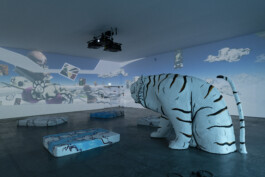
The cloud workshop
In the heart of Gaza, at the Eltiqa gallery, one of only two in the city, fourteen artists were invited by the Hawaf collective to participate in one of the first workshops of the Sahab
Museum: The Cloud Workshop. From February to April 2023, visual artists, street artists, illustrators, video artists, born between 1990 and 2000, met to create the first work of this museum-in-the-making. The result is a collective canvas representing a panoramic view of the imaginary museum, inspired by the cloud drawn by Salman Nawati.
In order to think together about the museum of their dreams, they were then asked to choose a work of art, a memorial object, an everyday artifact... that they would like to donate to the
museum. The proposed objects reflect an individual or collective history that breaks the hierarchies between minor and major arts and forms a strange collection, in the literal sense of the word: out of the ordinary, bizarre, unusual. These objects are scanned, digitized to be transported into digital space, and become accessible through the technique of augmented reality, which gives access to a more intimate vision of the creative process. In an interactive way, the visitor of the exhibition is invited to go and find, with the help of his smartphone, the objects hidden in the collective canvas.
L'Atelier du nuage seems to revisit the cabinet of curiosities, the ancestor of museums. Just like these places in which a multitude of heterogeneous objects were collected, L'Atelier du nuage reminds us of this "microcosm or summary of the world" according to the words of Krzysztof Pomian. Thus, at the time of the increasing confinement of this enclave under asphyxia, it is an artistic "abridgment of its universe" which wants to be without limits.
The collective canvas was sewn in Gaza, then sent to Jerusalem, Ramallah, Tel Aviv, then Leipzig before being sent to Paris. Postal services do not operate in Gaza.
Participating artists
Adam Al-Mghari (Gaza, 1989. Lives in Gaza)
Aboud Nasser (Gaza, 2000. Lives in Gaza)
Bayan Abu Nahla (Gaza, 2001. Lives in Gaza)
Amal Al-Nakhala (Gaza, 1999. Lives in Gaza)
Rawan Murad (Gaza, 1998. Lives in Gaza)
Sobhi Qouta (Gaza, 1990. Lives in Gaza)
Samar Sharaf (Kiev, 2004. Lives in Gaza)
Hamada Alkept (Gaza, 1994. Lives in Gaza)
Fouad Khater (Gaza, 1997. Lives in Gaza)
Hazem Alzomar (Gaza, 1989. Lives in Gaza)
Jehad Al-Ghoul (Gaza, 1992. Lives in Gaza)
Enas Rayyan (Gaza, 2003. Lives in Gaza)
Ahmed Abunada (Gaza, 1996. Lives in Gaza)
Sahab, the Cloud museum
In Gaza, a territory under embargo and deprived of a museum, the collective Hawaf ("margins" in Arabic) conceived a museum against destruction and oblivion. A museum that protects the archaeological, historical and artistic heritage of this confined enclave, where the only way to dream is to look at the sky.
From then on, the cloud proves to be the most appropriate and safest place to build this museum of possibilities. In 2021, somewhere in the cloud between Gaza and Paris, the Sahab ("clouds") museum was born, on the initiative of artists and architects, composite dreamers. A museum of refuge, therapeutic, it preserves the past of Palestine, to better face the present and draw the contours of a better future. As a "borderless" museum, it intends to bring Gaza out of its isolation, thanks to digital space and virtual reality. Through workshops, material and digital works are created by the dispersed community of Palestinians who are (re)cemented by the collective construction of the museum and its collections. In the future, this virtual museum will be embodied in a tangible way on the territory of a liberated Gaza.
Marion Slitine
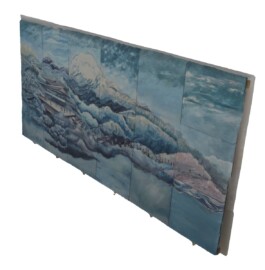
WORKSHOP in partnership with association La Sierra Production and Art Explora, Paris, Cité des Arts, June 2022
The workshop comes within the framework of cooperation between Association La Sierra Prod and Art Explora and HAWAF group within the framework of my residency in the City of Arts through the artistic grant from Art Explora.
At the beginning I conducted an acquaintance workshop with children, in which the children got to know Gaza city and the reason for my residency (SAHAB Museum -The imaginary of Gaza), the children drew their imagination about the museum.
In the second workshop was in the City of Arts on Montmartre, where the children conducted a joint workshop via video online with children from Gaza, in which they got to know each other, and asked different questions to each other, then I asked the children to imagine Paris without museums and trying to build it from the surrounding natural tools, the result was amazing.
In the third meeting, children went to the Museum of the Bourse de Commerce and filmed the artworks, as trainers we filmed their emotions and interaction with the artworks.
In the last meeting, we conducted a workshop to produce artworks with children for the museum, in partnership with Andres Burbano. The works were photographed in VR digital technic, then uploaded to the application BavAR[t] in cooperation between Hawaf Group and the application’s team.
The experience was more than wonderful.
Salman Nawati
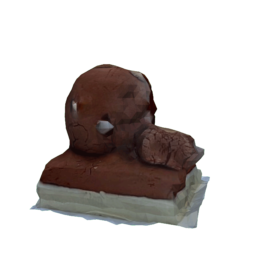
Extraterrestrial, by Kadi
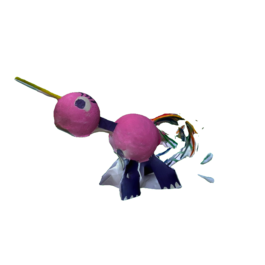
Jasmine, by Lili
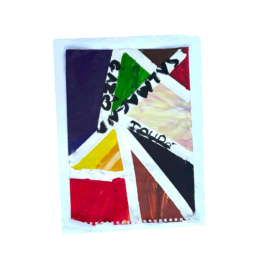
1998-2098, by Fatou
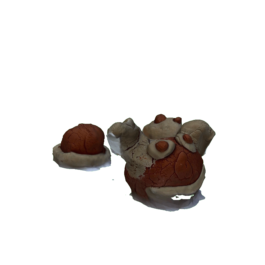
Peppa Pig, Little Brown Bear, a Ram,
a Planet and unfinished Zombie, by Ivan
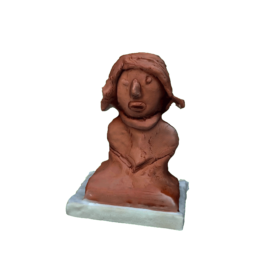
Videoplant, by Imane
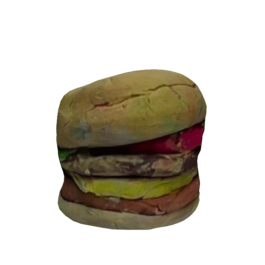
Burger légenaire, by Aminata
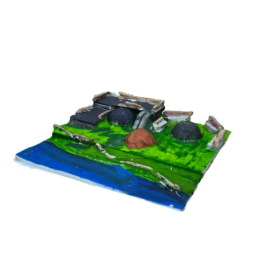
Jardin miniature [Miniature Garden], by Rayane

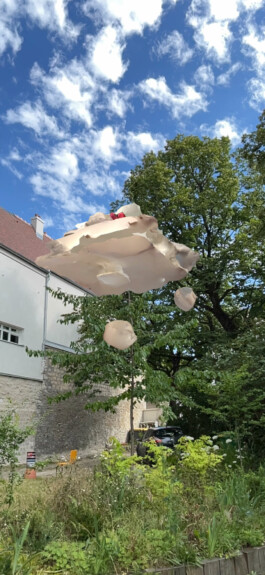
Filters created for the workshop

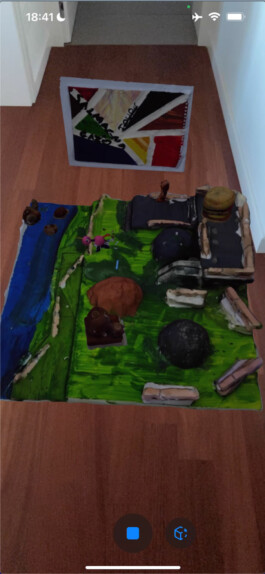
Filters created for the workshop
RADIO BROADCAST Interview of Hawaf on Radio Monte Carlo Doualiya, Paris, June 2022
WORKSHOP Online workshop with the children from Gaza, Paris-Gaza, June 2022

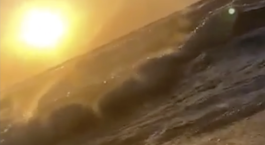
SYMPOSIUM Mucem, Marseille, June 2022
An encounter between artists and researchers "Gaza’s Museum of Futures. Futurisms and alternative museologies", Wednesday June 1, 2022, Mucem (MucemLab), Marseille.
During their residence at the Cité internationale des arts in Paris, HAWAF collective (Mohamed Bourouissa, Salman Nawati, Mohamed Abusal and Sondos Al-Nakhala) presented at the Mucem its project "SAHAB. Museum of the clouds of Gaza", a virtual reality museum, on the cloud, in the open air, for a territory under embargo. In order to trace its heritage and art, and to imagine its history in the future, this project in the making is put in dialogue with artistic and museum creations that use the grammar of "possibilities" to build a critical discourse of the present.
This day is conceived as an artistic and scientific meeting, where artists, filmmakers, researchers, curators, and museologists confront their own views about this project of a museum of the future of Gaza. This day is co-organized in partnership with the Cité Internationale des Arts where a public presentation will take place on May 30, 2022.
Scientific coordination
Marion Slitine and Aude Fanlo
MucemLab, Mucem, Marseille
Organized by
Mucem - La Cité internationale des arts - Institut Français
With the support of
Fondation Art Explora - Ateliers Médicis - Les rencontres à l'échelle - Centre Norbert Elias
More information on the Mucem website: https://www.mucem.org/programme/autour-du-musee-des-futurs-de-gaza
[01] Intro - autour du musée des futurs de Gaza
[02] Joan Grandjean - et si des futurismes
[03] Mounir Ayache - SF orientale et l'arabofuturisme
[04] Makan Fofana - La banlieue du turfu
[05] Discussion - Territoire, science-fiction et création
[06] Discussion collective HAWAF
[07] Discussion - Muséofuturismes, Thomas Bellinck
[08] Bochra Triki - Le musée national des libertés sauvages en captivité
[09] Youness Atbane - 14km, le musée imaginaire
[10] Giorgio De Finis - l'art, l'autre et l'ailleurs
[11] Table ronde - Muséofuturisme
[12] Conclusions - Rania Stephan, Julien Wacquez, Emmanuel Grimaud
EVENT Instituts Français de Gaza et Ramallah + online, November 2022
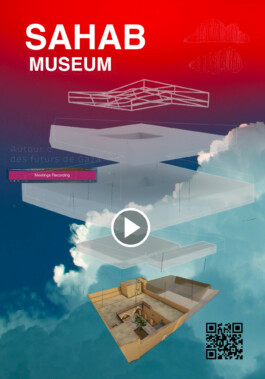
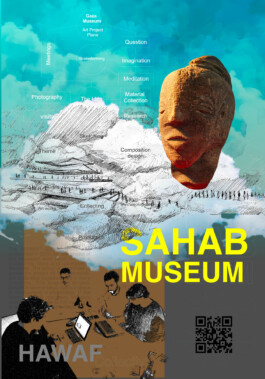
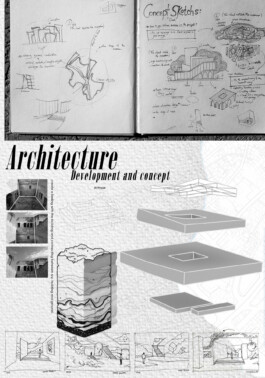
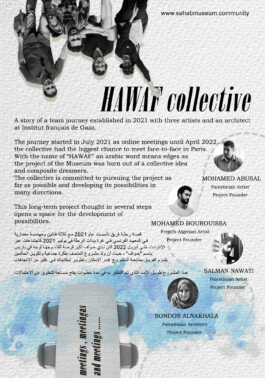
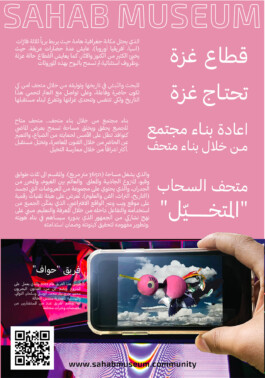
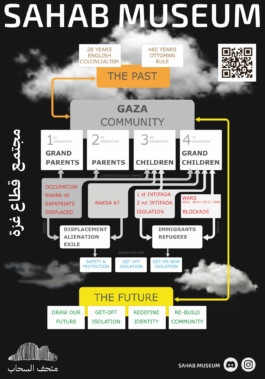
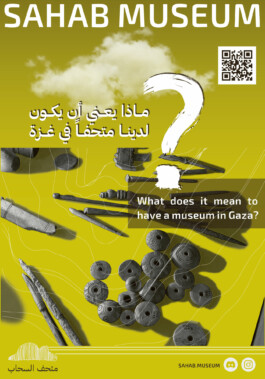
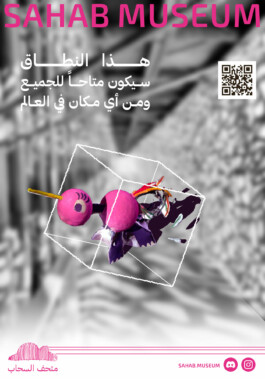

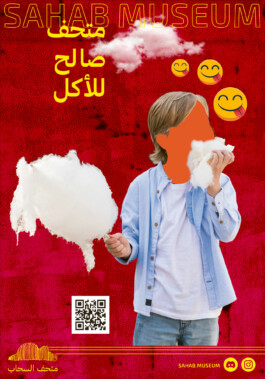
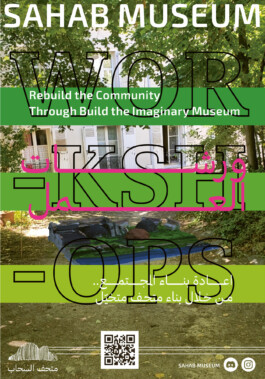
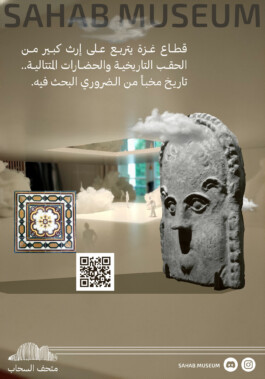
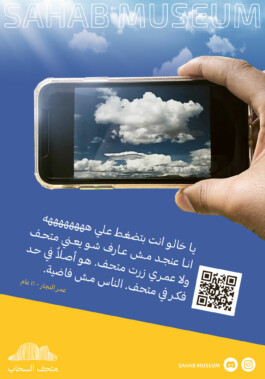
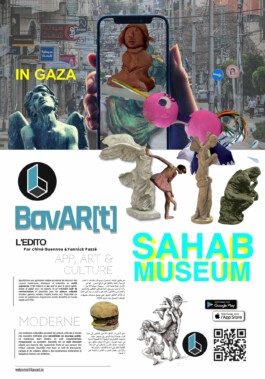
THE STORY
Text of the story from the installation A Place to Be
Story: Salman Nawati & David Pickering for Hawaf
Voice: Hiam Abbass
Music: LILA
Post-production, mixing and mastering: Éliane Blaise alias æfv
A long time ago, I left the imaginary world for the real one. I came looking for the person who imagined me. The other imaginary creatures warned me not to be too curious. In the real world, the ground was hard and littered with stones, not soft and silky clouds. In the real world, there were walls, and sometimes they trapped people, or even collapsed on them. But I am a curious tigress, so I refused to listen.
One day, I sat on a dark rain cloud, until it split in two. Down... down... down I fell to the earth below. I suddenly found myself on a beautiful beach where the smell of salt hung in the air. I saw a distant city and wondered where I was. Did the person who imagined me live here? I decided to take a stroll to find out. I heard vendors selling yams and ice cream. I could also hear the lively laughter of children. I went up to a little boy and asked: "Little boy, was it you who imagined me?” But he took one look and ran away. I thought it best to avoid these humans for now. They were too emotional and quick to judge. In the daytime, I'd hide on the rocky shoreline listening to the crash of waves, kids laughing, and crabs scurrying.
One night, my eyes met a young man's. I saw him and he saw me too. Like me, he was walking the streets at night. It was my first time meeting a real human, and his first time meeting an imaginary tigress. We stared at each other in total silence. Our eyes locked, each waiting for the other to speak. After some time, our gazes softened and trust crept into our eyes. We started to feel safe with one other. He cared for me as no imaginary creature ever had. He taught me to love reality, so much that I didn't want to go home. We lived together for many years. Best of all, he showed me his city, the city of Gaza. You can read its history in the streets. This city is not ashamed to tell its secrets. Its people are kind and generous. It is a city worth loving. The beauty is that nothing can touch it, and yet it touches the whole world.
One day, a terrible storm hit, the worst I'd ever seen. The wind howled so loudly we couldn’t sleep. Thunder shook the ground beneath us. The storm nearly blew the house down. Food and water were cut off for days. Finally, we had to evacuate. There was no safe place to go. I offered to take him to my world, the world of imagination. I tried to convince him, saying: "If you stay here, you will die." He replied: “Have a little patience. The storm will lift and the difficult time will pass.” I fell silent and began to cry. But I believed him and decided to stay. He was right, the storm passed and the sun returned. For a while, everything was quiet. But soon another storm came, and then another. And so it was that storm followed sunshine, and sunshine followed storm. I watched my beloved become a beautiful old man. But I, being imaginary, had not aged a day. After he died, I hid in the place he built for me, wondering what to do. I was now stuck in the real world, but had no human connection to it. How could I get back to the world of imagination?
One morning, a group of youths came to the house. They were my beloved's grandkids: 2 boys, 1 girl. They'd come to pack up his things. When they saw me, they wondered: "What is a tigress doing here? How long has she lived with Grandpa?" The boys were afraid, but not the girl. She was amazed. She looked into my eyes as nobody ever had, not even her grandfather. “I know you,” she said. “I'm the one who imagined you.” I learned she'd sketched me on paper. Turns out, her job was to imagine things: creatures, colors, sounds, landscapes, objects... and even cloud formations. She listened as I described my world, captivated by every detail. But she already knew all about it. I was happy to reminisce about home. To be honest, I was beginning to miss it. All day and night, I described each cloud, each rainbow, and all my memories from home. Once I had finished, they all begged me: “Please take us there!”
We left after midnight, when the city was already asleep. They hid me in a trunk. I couldn't see. Finally, after an eternity, we arrived at the deserted airport. When they opened the trunk, I saw the full moon and felt a cool breeze. Then I roared the roar that only a tiger can roar... Immediately, the moon shone brighter. A portal opened between reality and imagination. They traded reluctant, uncertain looks. They were content and yet unsure. One called it an impossible dream-come-true. But faced with the opportunity, they couldn't choose. Deciding to live in an imaginary world isn't easy. The granddaughter decided to go. "This is a lifelong dream," she said. "I may not get another chance." One brother decided to come along, but the other was reluctant. "Though I'd like to see the imaginary world, one of us must stay behind to tell the tale.”
We entered the portal, crossed borders and swam through clouds. We saw other people swimming too. The sky lit up with many colors, clouds gathered and dispersed. The wind carried us across the sky. We reached my place: the world of imagination. This was absolute freedom. The girl reached out to touch a painting, but it slipped through her fingers. She laughed. This was the world of imagination, where artists draw and color their lives, record their pasts, and tell their stories. Here, they weave their future into clouds for all to see...
Hawaf Group, D.R., 2024

Presented for the first time at Palais de Tokyo, the work conceived by hawaf collective plunges us into the fantastic story of a tigress who sets out to meet the world of humans, through an immersive installation that takes us from Gaza City to the sky and sahab museum. At the same time, thanks to a terminal system, an interactive experience invites visitors to design their own exhibition based on a collection of paintings by artists from Gaza.
Visitors can create a collection of paintings within the film, which mingle with other forms, elements, sculptures and imaginaries created during workshops with children in France. Through its various connections, here and elsewhere, the museum becomes a sensitive platform for connecting the creation of Gaza with that of the rest of the world. The terminals also offer the public the chance to become members of hawaf association and, in return for a donation, obtain a poster made from their selection of works to support the development of sahab museum project.
This invitation to delve into sahab museum, its origins, its collections, but also the dream from which it sprang engages in the real the implementation of a vision: through the construction of the museum, to rebuild the community.
Image caption: Mohamed Bourouissa, SIGNAL, Palais de Tokyo, 16.02.2024 - 30.06.2024. Crédit photo Aurélien Mole. © ADAGP, Paris,2024
The cloud workshop
In the heart of Gaza, at the Eltiqa gallery, one of only two in the city, fourteen artists were invited by the Hawaf collective to participate in one of the first workshops of the Sahab
Museum: The Cloud Workshop. From February to April 2023, visual artists, street artists, illustrators, video artists, born between 1990 and 2000, met to create the first work of this museum-in-the-making. The result is a collective canvas representing a panoramic view of the imaginary museum, inspired by the cloud drawn by Salman Nawati.
In order to think together about the museum of their dreams, they were then asked to choose a work of art, a memorial object, an everyday artifact... that they would like to donate to the
museum. The proposed objects reflect an individual or collective history that breaks the hierarchies between minor and major arts and forms a strange collection, in the literal sense of the word: out of the ordinary, bizarre, unusual. These objects are scanned, digitized to be transported into digital space, and become accessible through the technique of augmented reality, which gives access to a more intimate vision of the creative process. In an interactive way, the visitor of the exhibition is invited to go and find, with the help of his smartphone, the objects hidden in the collective canvas.
L'Atelier du nuage seems to revisit the cabinet of curiosities, the ancestor of museums. Just like these places in which a multitude of heterogeneous objects were collected, L'Atelier du nuage reminds us of this "microcosm or summary of the world" according to the words of Krzysztof Pomian. Thus, at the time of the increasing confinement of this enclave under asphyxia, it is an artistic "abridgment of its universe" which wants to be without limits.
The collective canvas was sewn in Gaza, then sent to Jerusalem, Ramallah, Tel Aviv, then Leipzig before being sent to Paris. Postal services do not operate in Gaza.
Participating artists
Adam Al-Mghari (Gaza, 1989. Lives in Gaza)
Aboud Nasser (Gaza, 2000. Lives in Gaza)
Bayan Abu Nahla (Gaza, 2001. Lives in Gaza)
Amal Al-Nakhala (Gaza, 1999. Lives in Gaza)
Rawan Murad (Gaza, 1998. Lives in Gaza)
Sobhi Qouta (Gaza, 1990. Lives in Gaza)
Samar Sharaf (Kiev, 2004. Lives in Gaza)
Hamada Alkept (Gaza, 1994. Lives in Gaza)
Fouad Khater (Gaza, 1997. Lives in Gaza)
Hala Alabassi (Gaza, 2001. Lives in Gaza)
Hazem Alzomar (Gaza, 1989. Lives in Gaza)
Jehad Al-Ghoul (Gaza, 1992. Lives in Gaza)
Enas Rayyan (Gaza, 2003. Lives in Gaza)
Ahmed Abunada (Gaza, 1996. Lives in Gaza)
WORKSHOP in partnership with association La Sierra Production and Art Explora, Paris, Cité des Arts, June 2022
The workshop comes within the framework of cooperation between Association La Sierra Prod and Art Explora and HAWAF group within the framework of my residency in the City of Arts through the artistic grant from Art Explora.
At the beginning I conducted an acquaintance workshop with children, in which the children got to know Gaza city and the reason for my residency (SAHAB Museum -The imaginary of Gaza), the children drew their imagination about the museum.
In the second workshop was in the City of Arts on Montmartre, where the children conducted a joint workshop via video online with children from Gaza, in which they got to know each other, and asked different questions to each other, then I asked the children to imagine Paris without museums and trying to build it from the surrounding natural tools, the result was amazing.
In the third meeting, children went to the Museum of the Bourse de Commerce and filmed the artworks, as trainers we filmed their emotions and interaction with the artworks.
In the last meeting, we conducted a workshop to produce artworks with children for the museum, in partnership with Andres Burbano. The works were photographed in VR digital technic, then uploaded to the application BavAR[t] in cooperation between Hawaf Group and the application’s team.
The experience was more than wonderful.
Salman Nawati

Extraterrestrial, by Kadi

Jasmine, by Lili

1998-2098, by Fatou

Peppa Pig, Little Brown Bear, a Ram,
a Planet and unfinished Zombie, by Ivan

Videoplant, by Imane

Burger légenaire, by Aminata

Jardin miniature [Miniature Garden], by Rayane


Filters created for the workshop


Filters created for the workshop
WORKSHOP Online workshop with the children from Gaza, Paris-Gaza, June 2022


SYMPOSIUM Mucem, Marseille, June 2022
An encounter between artists and researchers "Gaza’s Museum of Futures. Futurisms and alternative museologies", Wednesday June 1, 2022, Mucem (MucemLab), Marseille.
During their residence at the Cité internationale des arts in Paris, HAWAF collective (Mohamed Bourouissa, Salman Nawati, Mohamed Abusal and Sondos Al-Nakhala) presented at the Mucem its project "SAHAB. Museum of the clouds of Gaza", a virtual reality museum, on the cloud, in the open air, for a territory under embargo. In order to trace its heritage and art, and to imagine its history in the future, this project in the making is put in dialogue with artistic and museum creations that use the grammar of "possibilities" to build a critical discourse of the present.
This day is conceived as an artistic and scientific meeting, where artists, filmmakers, researchers, curators, and museologists confront their own views about this project of a museum of the future of Gaza. This day is co-organized in partnership with the Cité Internationale des Arts where a public presentation will take place on May 30, 2022.
Scientific coordination
Marion Slitine and Aude Fanlo
MucemLab, Mucem, Marseille
Organized by
Mucem - La Cité internationale des arts - Institut Français
With the support of
Fondation Art Explora - Ateliers Médicis - Les rencontres à l'échelle - Centre Norbert Elias
More information on the Mucem website: https://www.mucem.org/programme/autour-du-musee-des-futurs-de-gaza
[01] Intro - autour du musée des futurs de Gaza
[02] Joan Grandjean - et si des futurismes
[03] Mounir Ayache - SF orientale et l'arabofuturisme
[04] Makan Fofana - La banlieue du turfu
[05] Discussion - Territoire, science-fiction et création
[06] Discussion collective HAWAF
[07] Discussion - Muséofuturismes, Thomas Bellinck
[08] Bochra Triki - Le musée national des libertés sauvages en captivité
[09] Youness Atbane - 14km, le musée imaginaire
[10] Giorgio De Finis - l'art, l'autre et l'ailleurs
[11] Table ronde - Muséofuturisme
[12] Conclusions - Rania Stephan, Julien Wacquez, Emmanuel Grimaud
EVENT Instituts Français de Gaza et Ramallah + online, November 2022

















